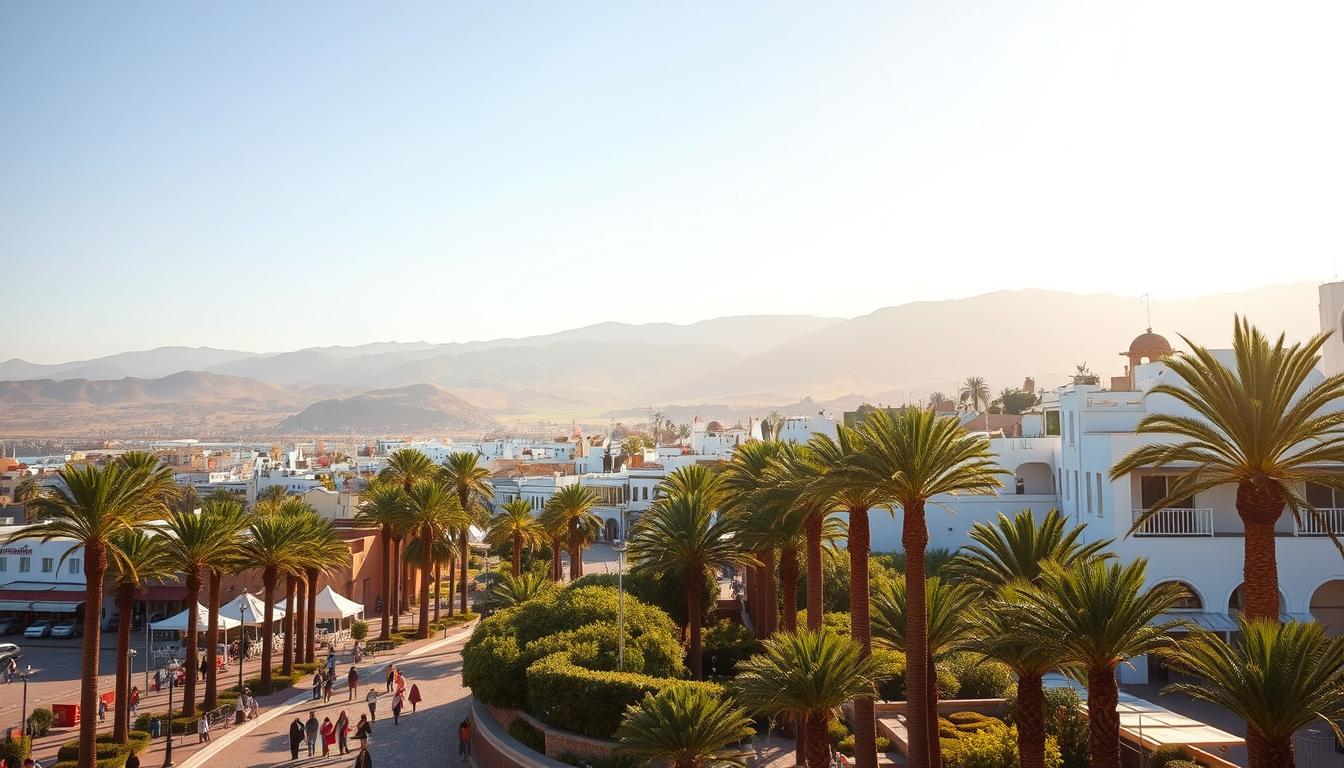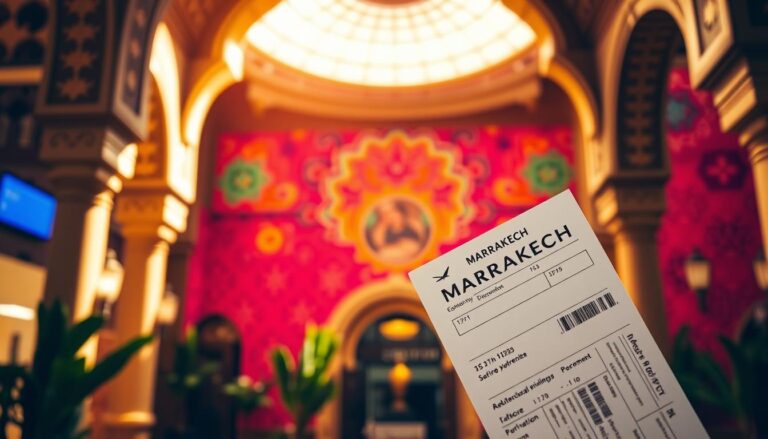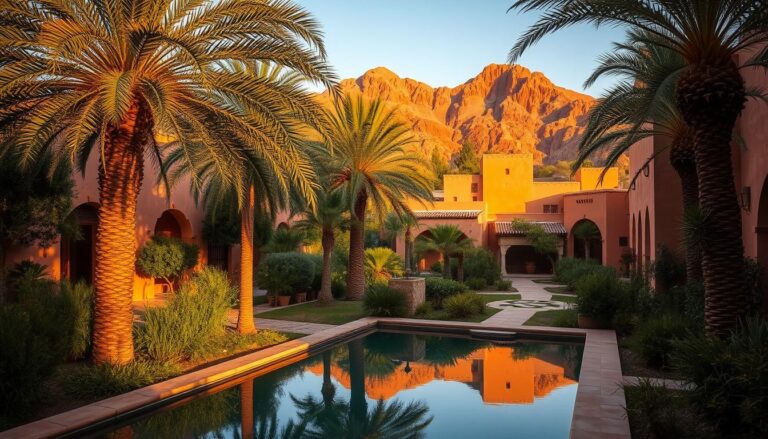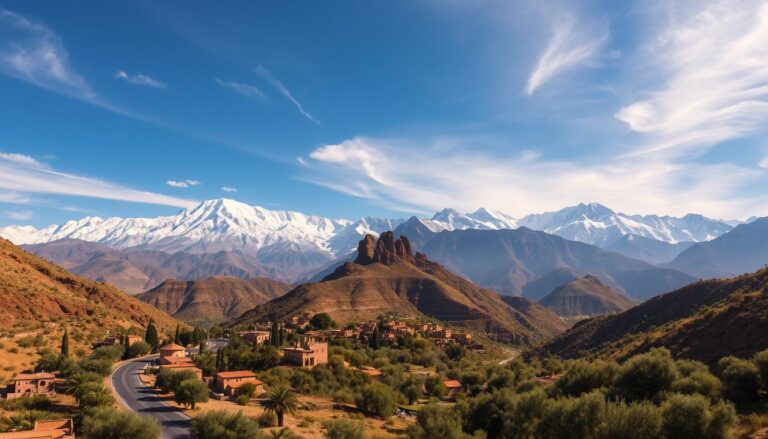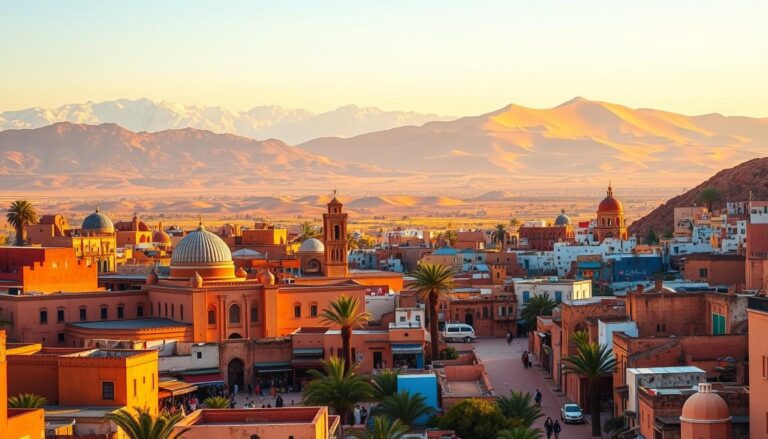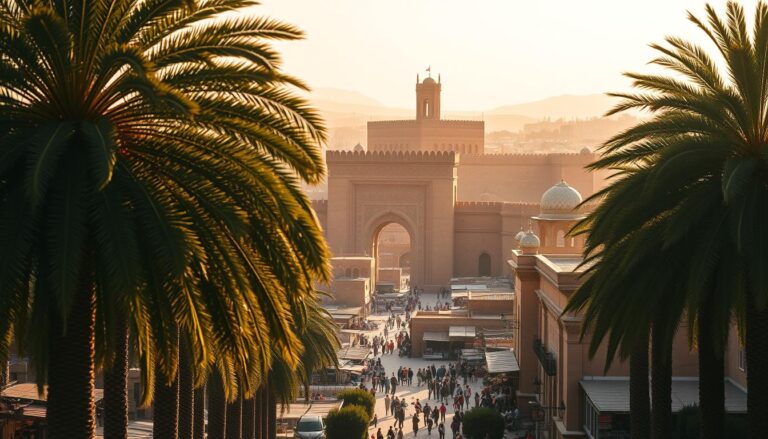Agadir City: A Vibrant Moroccan Destination
Table of Contents
A staggering 15,000 lives were lost in just 15 seconds when a catastrophic earthquake levelled this coastal settlement in 1960. Today, over six decades later, you’ll find a completely reimagined urban landscape where wide palm-lined avenues meet traditional Moroccan hospitality.
Nicknamed ‘The White City’ for its gleaming buildings tumbling towards a crescent-shaped bay, this destination blends modern convenience with cultural authenticity. Unlike Marrakech or Fez, you won’t encounter labyrinthine medinas here – instead, discover spacious parks framing contemporary architecture that nods subtly to Berber design traditions.
The reconstruction effort created something extraordinary: a forward-thinking metropolis powered by university campuses and beachfront innovation. Nearly 70% of residents are under 35, infusing streets with youthful energy that spills into bustling cafés and artisanal markets.
What truly surprises visitors is how seamlessly the past integrates with the present. Between glass-fronted shopping centres, you’ll stumble upon preserved Amazigh craft workshops and family-run tagine restaurants using century-old recipes. This harmonious duality makes every stroll through the urban fabric an exercise in time travel.
Key Takeaways
- Discover a coastal hub rebuilt from ruins into a model of modern urban planning
- Experience striking whitewashed architecture cascading towards Atlantic shores
- Enjoy spacious green areas rarely found in North African destinations
- Engage with a youthful population shaping contemporary Moroccan culture
- Find unexpected blends of tradition and innovation around every corner
Introduction to Agadir: A Modern Coastal Gem
Imagine a place where golden sands meet Atlantic breezes, creating a playground for sun-seekers and adventurers alike. This coastal hub’s strategic position near the Canary Islands gifts it with year-round mild weather, perfect for swapping winter coats for swimwear. Gentle waves lap against a nine-kilometre shoreline, protected from harsh desert winds by the Anti-Atlas mountains.
Unique Coastal Features and Sun-Kissed Beaches
You’ll find one of Morocco’s most swimmable shores here, with calm waters ideal for paddleboarding or simply floating under cobalt skies. The beach transforms throughout the day – morning joggers give way to afternoon sunbathers, then couples strolling at sunset.
Surfers praise the consistent breaks, while families appreciate the gradual shelf into deeper waters. Beachfront kiosks serve mint tea alongside freshly grilled sardines, letting you refuel without leaving your sun lounger.
Vibrant Nightlife and Urban Charm
As stars emerge, the promenade comes alive with open-air concerts and the clink of cocktail glasses. Modern lounge bars mix traditional Moroccan hospitality with cosmopolitan flair – think argan oil-infused mocktails paired with live Gnawa music.
The marina dazzles after dark, its boardwalk lined with seafood restaurants serving just-caught dorado. Trendy boutiques stay open late, offering everything from handwoven rugs to contemporary ceramics. Whether you prefer moonlit beach walks or dancing till dawn, this destination delivers unforgettable evenings.
Discovering Agadir City: Tradition Meets Modernity
February 1960 rewrote this destination’s story when seismic tremors lasting mere seconds erased generations of history. What emerged from the dust became a masterclass in urban reinvention, where respect for heritage walks hand-in-hand with progressive design.
Rebirth After the 1960 Earthquake
The 5.8-magnitude quake didn’t just topple buildings – it obliterated 95% of structures in under a minute. You’ll struggle to find physical remnants of pre-1960 life, as planners consciously designed a fresh blueprint prioritising earthquake resistance and community spaces.
Architects faced a unique challenge: creating a functional modern hub while honouring Moroccan identity. Their solution? Whitewashed buildings with geometric patterns echoing Berber textiles, and minarets rising beside contemporary civic centres.
A Harmonious Blend of Old and New
Stroll past the seafront’s glass-fronted hotels and you’ll suddenly encounter hole-in-the-wall workshops hammering out brass lanterns. The souk’s maze-like alleys sit minutes from wide boulevards, both buzzing with equal fervour.
Notice how mosque courtyards incorporate zen-inspired water features, blending Islamic traditions with global design trends. Even the marina’s yachts bob alongside fishing dhows using centuries-old netting techniques.
This phoenix-like transformation proves disasters can birth opportunities. Wider streets improved emergency access, while clustered neighbourhoods foster stronger community bonds – unexpected silver linings from unimaginable loss.
Vibrant Beach Life and Seafront Leisure
The rhythmic crash of Atlantic waves welcomes you to a nine-kilometre stretch of golden perfection. Soft sands cushion your steps as you explore this urban shoreline, where sun-bleached loungers line the water’s edge. Morning light paints the promenade in warm hues, revealing cafés serving freshly squeezed orange juice alongside aromatic mint tea.
Experience the Golden Sands and Blue Waters
Your beach day here offers more than sunbathing. Thrill-seekers harness Atlantic breezes with kitesurfing jumps, while beginners master windsurfing in calmer shallows. Jet skis carve foamy trails across the bay, contrasting with traditional fishing boats bobbing near the horizon.
Prefer land-based adventures? Quad bikes kick up sand clouds along designated dune routes. Further inland, camel trains offer leisurely paced tours past swaying argan trees. These activities spread across the vast shoreline, ensuring you’ll never feel crowded.
As the sun dips, beachfront restaurants grill today’s catch over aromatic charcoal. Savour buttery sardines or tender calamari while watching paragliders silhouette against tangerine skies. Just remember – those inviting waves hide strong currents. Always swim between lifeguard flags for a safe, unforgettable experience.
Historical Landmarks: Kasbah Agadir Oufella and Beyond
What stories could ancient stones whisper if they could speak? Perched like a weathered sentinel, Kasbah Agadir Oufella gazes over the coast from its 240-metre-high throne. This hilltop fortress embodies resilience, having witnessed centuries of conquests and natural disasters.
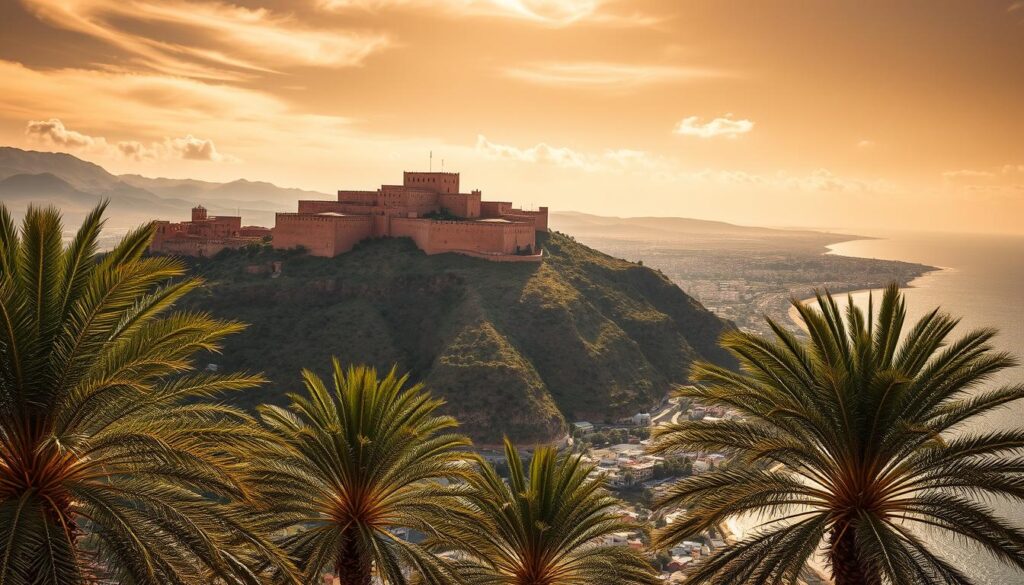
The Fortified Kasbah on the Hill
Your ascent reveals a 16th-century marvel built by Saadi dynasty ruler Mohamed Ech-Cheikh. Strategically positioned against Portuguese invasions, its walls once sheltered bustling markets and a mosque. Today, crumbled arches frame panoramic ocean vistas stretching to the horizon.
Look for the intriguing Dutch inscription near the entrance – “Vreest God ende eert den Kooning” (Fear God and honour the King). Dated 1746, it hints at colonial-era trade connections that shaped Morocco’s history.
Cable Car Rides and Panoramic Views
Skip the steep climb by gliding up in a glass-walled cable car. During your five-minute journey, watch the urban tapestry unfold beneath you like a living map. The hill’s summit rewards you with uninterrupted views of fishing ports merging into modern marinas.
Time your visit for sunset when golden light bathes the ruins. It’s an experience that connects you to generations of traders, soldiers and craftsmen who once walked these grounds. Just don’t forget your camera – every angle begs to be photographed.
The Enchanting New Medina Experience
Five kilometres south of bustling centres, a 1992 architectural marvel quietly honours Morocco’s cultural memory. Italian designer Coco Polizzi conceived this 4.5-hectare tribute to pre-earthquake heritage, prioritising authentic craftsmanship over hurried tourism. Unlike typical marketplaces, the space feels more like an open-air museum where tradition breathes through every archway.
Traditional Architecture and Artisan Craftsmanship
Your exploration reveals honey-coloured walls blending Berber geometrics with Mediterranean flourishes. Notice how wooden moucharabieh screens filter sunlight onto zellige tilework – a masterclass in regional design principles. Twelve thousand square metres house workshops where artisans hammer copper and spin wool using methods unchanged for generations.
Three compelling reasons make this area unique:
| Feature | Experience | Benefit |
|---|---|---|
| Living Workshops | Watch pottery throwing & textile weaving | Direct purchases from makers |
| Cultural Amphitheatre | Traditional music performances | Immersive heritage experiences |
| Architectural Details | African-Mediterranean fusion styles | Photogenic backdrops |
The medina’s peaceful lanes offer respite from busier places, inviting leisurely strolls past aromatic bakeries. Don’t miss the amphitheatre’s evening shows, where local musicians transform ancient ballads into vibrant performances. It’s these thoughtful touches that elevate the new medina from mere replica to living heritage hub.
As you sip mint tea in shaded courtyards, appreciate how this space bridges past and present. Artisans here don’t just preserve techniques – they adapt them for contemporary tastes, ensuring Morocco’s craft legacy thrives. The result? One of North Africa’s most authentic cultural preservation projects, hidden in plain sight.
Unravelling Agadir’s Cultural Heritage and Festivals
Step into a world where ancient traditions pulse through modern celebrations. This coastal destination thrums with cultural energy, offering immersive experiences that connect you to Morocco’s indigenous roots. From museum treasures to open-air concerts, every encounter reveals layers of heritage shaped by resilient communities.

Timitar Festival Highlights
Feel the ground vibrate as drums merge with electric guitars during July’s Timitar Festival. Over 400 artists transform streets into stages, blending Amazigh folk melodies with global beats. You’ll find yourself dancing alongside locals to Gnawa trance rhythms one moment, then swaying to French pop covers the next.
| Festival Feature | Visitor Experience | Cultural Impact |
|---|---|---|
| Three Main Stages | Discover emerging Moroccan talents | Showcases regional diversity |
| Street Performances | Join spontaneous dance circles | Democratises art access |
| Workshop Zones | Learn traditional instrument basics | Preserves craft techniques |
Insights from the Amazigh Museum
The Musée du Patrimoine Amazigh reveals centuries of Berber ingenuity through its three-floor collection. Your journey begins with ceremonial silver jewellery, each piece telling stories of tribal identity. Upstairs, vibrant wool carpets display geometric patterns that map ancestral journeys across desert landscapes.
Don’t rush past the pottery exhibits. These clay vessels demonstrate how people adapted designs to daily needs – water jars with narrow necks to reduce evaporation, cooking pots with wide bases for even heat distribution. It’s a masterclass in functional artistry that still influences Moroccan design today.
Time your visit to catch live demonstrations. Watching artisans recreate museum pieces using ancient methods makes history feel deliciously tangible. You’ll leave understanding how past and present coexist in this ever-evolving cultural hub.
The Colours and Aromas of Souk El Had Market
Step through one of thirteen arched gateways into a sensory wonderland where 6,000 stalls sprawl across 13 hectares. This labyrinthine market operates six days weekly, closing only on Mondays to recharge its infectious energy. Your nostrils catch cinnamon first, then cardamom – a spice-scented breadcrumb trail leading deeper into the maze.
Bargain Hunting and Haggling Tips
Leave your fixed-price mindset at the entrance. Traders here relish the dance of negotiation – start by offering 40% of the asking price. Watch their eyes; genuine smiles mean you’re close to a fair deal. Always carry dirham notes – cards gather dust in this cash-driven realm.
| Do’s | Don’ts | Pro Tip |
|---|---|---|
| Check multiple stalls | Show urgent desire | Learn “bsaḥ lkhir” (good morning) |
| Walk away politely | Accept first price | Bundle items for discounts |
| Count change carefully | Forget to smile | Carry reusable bags |
A Feast for the Senses with Spices and Textiles
Vendors sculpt saffron threads into golden pyramids while paprika cascades like scarlet waterfalls. Seek out the argan oil stalls where Berber women demonstrate traditional extraction methods. Rub the golden liquid into your hands – its nutty aroma lingers like liquid sunshine.
Textile alleys explode with colour: azure djellabas draped beside sunset-orange cushions. Run your fingers across hand-loomed fabrics – the bumpy texture reveals authentic craftsmanship. As day fades, follow the honey vendors’ calls to sample varieties flavoured with thyme or lavender.
Architectural Marvels: Mosques and Local Structures
Modern minarets pierce cobalt skies where spiritual life meets structural innovation. The coastal hub’s religious architecture reveals thoughtful design choices balancing tradition with post-earthquake practicality.
The Grand Mohamed V and Loubnan Mosques
You’ll find the majestic Mohamed V Mosque anchoring Nouveau Talborjt’s bustling streets. Rebuilt in 1960 after seismic destruction, its snow-white façade showcases intricate cedarwood lattices – a masterclass in earthquake-resistant design. The 45-metre minaret acts as both spiritual beacon and urban wayfinder, visible from distant neighbourhoods.
Head towards the seafront to discover Loubnan Mosque’s prime position between sun-bleached sands and busy shopping avenues. Opened by King Hassan II in 1969, its honey-toned arches welcome worshippers five times daily. Your visit might coincide with Friday prayers, when crowds spill onto surrounding pavements in quiet devotion.
While non-Muslims can’t enter these sacred spaces, their cultural significance resonates through exterior details. Observe the play of light on zellige tilework at dawn, or watch shadows dance across geometric stone carvings at dusk. These structures serve as living monuments to resilience, their doors open to all who appreciate craftsmanship with purpose.
Culinary Delights: Savouring Moroccan Flavours
Your taste buds embark on their own adventure here, where aromatic spice blends dance with sun-ripened ingredients. This coastal gem’s food scene mirrors its cultural duality – time-honoured recipes meet contemporary twists served with ocean views.
Traditional Tagines and Fresh Seafood
Clay pots simmering for hours deliver tender lamb with prunes or chicken layered with preserved lemons. Seek out family-run spots where recipes pass through generations – their saffron-infused couscous tastes like edible heritage. Along the marina, chefs grill today’s catch over almond wood, serving octopus carpaccio beside classic sardine tagines.
Three essential dining experiences:
- Sharing a communal mechoui (slow-roasted lamb) with locals
- Tasting amlou – argan oil dip with honey and almonds
- Sampling octopus from beachfront charcoal grills
Street Food and Local Restaurants
Follow the scent of baking bread to street stalls flipping msemen flatbreads. Crispy on the outside, stretchy within, these squares pair perfectly with mint tea. For quick lunches, try harira soup – tomato-lentil broth with chickpeas that warms like a hug.
Evening brings sophisticated choices along Boulevard Mohammed V. Modern bistros reimagine classics – think lamb burgers with harissa mayo or deconstructed pastilla parcels. Whether you’re grabbing quick bites or settling in for three-course feasts, every meal becomes a cherished memory.

